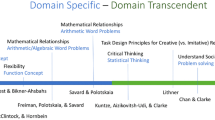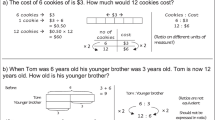Abstract
We examine the role of tasks that have the intended effect of teachers re-conceiving the mathematics they teach as comprising a coherent body of meaningful ideas. We ground our discussion in ideas of trigonometry and modular functions and draw from a professional development research project to illustrate our approach. In this project, many teachers experienced dissonance that was rooted in their commitments to their curricular knowledge of trigonometry. Teachers who built new meanings into a coherent whole were those who coordinated them at a micro level. Teachers who saw implications of their own reasoning for student learning were also successful at expressing that reasoning in natural language. We saw a similar pattern in the case of teachers' creation of meanings for action and process conceptions of mod(f(x),g(x)). Teachers who gained insight into implications of their own activities for student learning were the teachers who reasoned at a micro level in regard to the meaning of mod, who coordinated that meaning with a covariational perspective on the behavior of functions, and who expressed that coordination in natural language. We conclude that a primary feature of tasks that promote teachers' construction of coherent mathematical meanings is that they support an overall effort to have teachers engage in the coordination of meanings in the context of explaining significant ideas and relationships.








Similar content being viewed by others
Notes
If you put your calculator in degree mode, then sin(35) produces 0.5736 and cos(0.5736) produces 0.9999. However, if you enter cos(sin(35)), you will get 0.8399. Neither result is in degrees, but it is noteworthy that the stepwise process produces a different result than does the composition.
It would be more accurate to say that magnitude is the core concept. See Thompson & Saldanha (2003) for a discussion of magnitude versus measure.
Tangent might seem an exception, but one can standardize tangent in a triangle that has the circle’s radius as its horizontal leg. In that case, all values of tangent can be thought of as numbers of radii.
The grad (or grade, or gon), introduced in France circa 1900 and still used in engineering, is an arc whose length is 1/400th a circle’s circumference.
In the US, this way of thinking is captured by the mnemonic “SOH-CAH-TOA”, which stands for “Sine is Opposite over Hypotenuse”, “Cosine is …”, and so on.
The course website is at http://tpc2.net/Courses/Func1F05/.
We agree with one reviewer who noted that this percent is not a length, but we disagree that it is dimensionless. The unit of this percent is “radii per radius.”
Having the argument to sine and the value of sine measured in the same unit is why \( {\mathop {\lim }\limits_{x\;{\rightarrow}\;0} }\frac{{\sin \;x}} {x} = \frac{\pi} {{180}}. \) When x is in degrees, \( {\mathop {\lim }\limits_{x\;{\rightarrow}\;0} }\frac{{\sin \;x}} {x} = \frac{\pi} {{180}}. \) The reason is that when comparing the length of a very small arc to the y-coordinate of the arcs endpoint, they have about the same length when both are measured in units of one radius. The measure of the arc is about π/180 times the length of the y-coordinate when the arc is measured in units of 1/360th the circle’s circumference and the y-coordinate is measured in units of one radius. This is like saying the ratio of two equal lengths is 1 when we measure both in feet, while it is 12 when we measure one in feet and the other in inches.
As x gets larger, it has to vary less for x 2 to vary by 2π, and thus as x gets larger, sin(x 2) will go through more complete cycles for each increase in x of a given amount. Put another way, the graph generated parametrically as (x, y) = (t 2, cos(t 2)), 0 ≤ t ≤ 2π will generate a standard cosine graph over the interval [0,4π2].
We are reminded of Stigler et al.’s report of the TIMSS video study that while 38% of Japanese lessons and 28% of German lessons addressed a significant mathematical idea, 0% of US lessons did so (Stigler, Gonzales, Kawanaka, Knoll, & Serrano, 1999).
The selection of the mod function was motivated by one of us recalling a proof in real analysis that begins with the statement, “Let I be \( {\mathbb{R}}/\mathord 1 \), the real numbers mod 1.”
The expression “mod(x 2, 2)” for “x 2 mod 2” is due to Graphing Calculator’s syntax.
The graph of mod(x 2, cos(x)) is especially interesting. It becomes much more comprehensible when you superimpose the graphs of x 2 and \( {\left( {{\text{floor}}{\left( {\frac{{x^{{\text{2}}} }} {{\cos (x)}}} \right)}} \right)}\cos (x) \), where floor is ‘the greatest integer less than or equal to’ function.
Internalize and interiorize are Piagetian terms that distinguish between phases of idea development. At first one can carry out actions in thought, but later the person can anticipate the outcome of acting and take that anticipated outcome in place of having acted.
References
Carlson, M. P., Jacobs, S., Coe, E., Larsen, S., & Hsu, E. (2002). Applying covariational reasoning while modeling dynamic events: A framework and a study. Journal for Research in Mathematics Education, 33(5), 352–378.
Carlson, M. P., Oehrtman, M. C., & Thompson, P. W. (in press). Key aspects of knowing and learning the concept of function. In M. P. Carlson & C. Rasmussen (Eds.), Making the connection: Research and practice in undergraduate mathematics. Washington, DC: Mathematical Association of America. Available at http://pat-thompson.net/PDFversions/2006MAA%20Functions.pdf
Carlson, M. P., & Thompson, P. W. (2005, April). The reflexive relationship between individual cognition and classroom practices: A covariation framework and problem solving research informs calculus instruction. Paper presented at the Annual meeting of the American Educational Research Association. Montreal.
Cooper, R. G. (1991). The role of mathematical transformations and practice in mathematical development. In L. P. Steffe (Ed.), Epistemological foundations of mathematical experience (pp. 102–123). New York: Springer-Verlag.
Davydov, V. V. (1975). The psychological characteristics of the “prenumerical” period of mathematics instruction (A. Bigelow, Trans.). In L. P. Steffe (Ed.), Soviet studies in the psychology of learning and teaching mathematics (Vol. 7, pp. 109–206). Palo Alto, CA and Reston, VA: School Mathematics Study Group and National Council of Teachers of Mathematics.
Dewey, J. (1910). How we think. Boston: D. C. Heath.
Dubinsky, E., & Harel, G. (1992). The nature of the process conception of function. In G. Harel, & E. Dubinsky (Eds.), The concept of function: Aspects of epistemology and pedagogy (pp. 85–106). Washington, D. C.: Mathematical Association of America.
El’konin, D. B., & Davydov, V. V. (1975). Learning capacity and age level: Introduction (A. Bigelow, Trans.). In L. P. Steffe (Ed.), Soviet studies in the psychology of learning and teaching mathematics (Vol. 7, pp. 1–12). Palo Alto, CA and Reston, VA: School Mathematics Study Group and National Council of Teachers of Mathematics.
Piaget, J. (1977). Psychology and epistemology: Towards a theory of knowledge. New York: Penguin.
Piaget, J. (2001). Studies in reflecting abstraction (R. L. Campbell, Trans.). New York: Psychology Press.
Saldanha, L. A., & Thompson, P. W. (1998). Re-thinking co-variation from a quantitative perspective: Simultaneous continuous variation. In Proceedings of the Annual Meeting of the Psychology of Mathematics Education - North America. Raleigh, NC: North Carolina State University. Available at http://pat-thompson.net/PDFversions/1998SimulConVar.pdf
Silverman, J. (2004). The impact of students’ conceptualizations of mathematics on a computers in teaching and learning mathematics course. Phoenix, NV: Joint Mathematics Meeting of the American Mathematical Society and Mathematical Association of America.
Stigler, J. W., Gonzales, P., Kawanaka, T., Knoll, S., & Serrano, A. (1999). The TIMSS Videotape Classroom Study: Methods and findings from an exploratory research project on eighth-grade mathematics instruction in Germany, Japan, and the United States (National Center for Education Statistics Report No. NCES 99–0974). Washington, D.C.: U. S. Government Printing Office.
Thompson, P. W. (1994a). Images of rate and operational understanding of the Fundamental Theorem of Calculus. Educational Studies in Mathematics, 26(2–3), 229–274. Available at http://pat-thompson.net/PDFversions/1994Rate&FTC.pdf
Thompson, P. W. (1994b). The development of the concept of speed and its relationship to concepts of rate. In G. Harel & J. Confrey (Eds.), The development of multiplicative reasoning in the learning of mathematics (pp. 179–234). Albany, NY: SUNY Press. Available at http://pat-thompson.net/PDFversions/1994ConceptSpeedRate.pdf
Thompson, P. W. (2000). Radical constructivism: Reflections and directions. In L. P. Steffe & P. W. Thompson (Eds.), Radical constructivism in action: Building on the pioneering work of Ernst von Glasersfeld (pp. 412–448). London: Falmer Press. Available at http://pat-thompson.net/PDFversions/2000Constructivism-Ref’s&Dir’s.pdf
Thompson, P. W. (2002). Didactic objects and didactic models in radical constructivism. In K. Gravemeijer, R. Lehrer, B. v. Oers & L. Verschaffel (Eds.), Symbolizing, modeling and tool use in mathematics education (pp. 197–220). Dordrecht, The Netherlands: Kluwer. Available at http://pat-thompson.net/PDFversions/2002DidacticObjs.pdf
Thompson, P. W., & Saldanha, L. A. (2003). Fractions and multiplicative reasoning. In J. Kilpatrick, G. Martin & D. Schifter (Eds.), Research companion to the Principles and Standards for School Mathematics (pp. 95–114). Reston, VA: National Council of Teachers of Mathematics. Available at http://pat-thompson.net/PDFversions/2004FracsMultRsng.pdf
Acknowledgements
Research reported in this article was supported by National Science Foundation Grant No. EHR-0353470 and EHR-0412537. Any conclusions or recommendations stated here are those of the authors and do not necessarily reflect official positions of NSF.
Author information
Authors and Affiliations
Corresponding author
Rights and permissions
About this article
Cite this article
Thompson, P.W., Carlson, M.P. & Silverman, J. The design of tasks in support of teachers’ development of coherent mathematical meanings. J Math Teacher Educ 10, 415–432 (2007). https://doi.org/10.1007/s10857-007-9054-8
Received:
Accepted:
Published:
Issue Date:
DOI: https://doi.org/10.1007/s10857-007-9054-8




